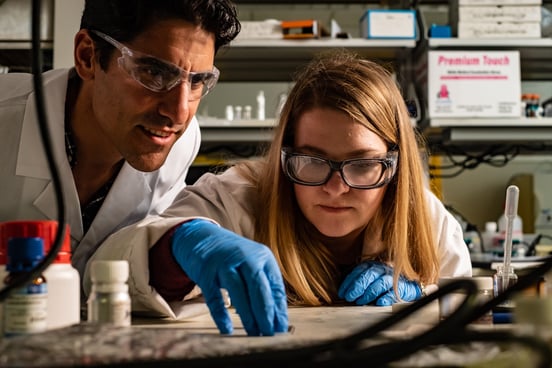A team at Rice University has developed a morphing material with much more than biomedical applications in mind.
Forward: features are independent pieces written for Mewburn Ellis discussing and celebrating the best of innovation and exploration from the scientific and entrepreneurial worlds.
The outlook for creating innovative industrial solutions through soft robotics has taken a step forward thanks to the work of a team at Rice University’s Brown School of Engineering. They’ve created what they describe as ‘complex shapeshifters’, which can morph from one form to another when exposed to changes in temperature, electrical current or stress, according to the university.
As Forward has recently reported, the idea of creating materials that alter their form when exposed to a particular stimulus isn’t unique. Importantly, however, the Rice team’s work involves a process of printing materials that can be ‘decoupled’ from the shaping process. The team refers to this as ‘reactive 4D printing’, since the forms produced change over time.
This approach, explains Rafael Verduzco, Associate Professor in the Department of Chemical and Biomolecular Engineering, ‘gives more flexibility in controlling the initial and final shapes and also allows us to print complex structures’.
Innovative ‘ink’
In developing the printing process, the team has created a liquid crystal elastomer ‘ink’ that incorporates ‘mutually exclusive sets of chemical links between molecules’. One link establishes the shape that will be printed, while the other is determined by a secondary process that involves shaping the material after the initial form is printed and dried. The second iteration of the form is then locked in through a curing process.
The materials in action
The ink uses the liquid crystal materials that are familiar parts of electronic displays and the like. These, Verduzco explains, ‘are very responsive, so, for example, you can apply an electric field and change the orientation of the molecules’.
‘We are taking these liquid crystals and attaching them to a polymer network,’ he continues. ‘We’re inventing these responsive molecules inside the polymer network, and that gives the overall material the ability to change shape whenever we change the orientation of the liquid crystal molecule.’
The team has been working in this field for about four years, explains Verduzco, who says ‘the big challenge for us and the field more broadly was the chemistry in making liquid crystal elastomers’. Earlier versions were polysiloxane-based, he notes, ‘which gives you very soft materials that are hard to handle’.
‘Over the past five years there have been a lot of advances in the chemistries,’ he adds. ‘Now we are using thiol-ene, and that has made it a lot easier to do things like printing the structures we describe in our paper.’
“We are looking at applications in things like ion transport for batteries, fuel cells or other electrochemical devices. Anywhere that you need some anisotropicity in the molecular orientation”
These structures could potentially have a biomedical use, perhaps even creating a sleeve that compresses or a soft robotic form that walks. However, Verduzco sees much more potential in the team’s discoveries. For instance, he has considered the idea of using liquid crystal elastomers to create tactile displays in cars, with buttons that pop up on the dashboard surface, perhaps activated by light, heat or an electric field. In fact, he says the team is now ‘swerving away from shape change and actuation, because there are other interesting properties these materials have’.

Rice engineer Rafael Verduzco and graduate student Morgan Barnes led the development of a method to 3D-print materials
that morph from one shape to another through application of temperature, electric current or stress.
Crucially, he points out, they are anisotropic: ‘They have different properties in one direction versus the other. So we are looking at applications in things like ion transport for batteries, fuel cells or other electrochemical devices.
‘The field has been really focused on soft robotics and shape changes and has overlooked their other applications and interesting properties.’
Find out more about this research here.
Pushing the boundaries
Matthew Smith, Partner and Patent Attorney at Mewburn Ellis comments:
"The team’s work on these liquid crystal elastomers is fascinating and pushes the boundaries of what can be done with materials that are reactive to environmental conditions. Patents directed to new materials like this are vital background IP, upon which further developments and innovations can be built. Further protection, for example encompassing particular end uses, products or methods, can then build out a strong portfolio of rights founded on the initial work."
Written by Caitlin Mackesy Davies
Images provided by Jeff Fitlow/Rice University
Matthew is a Partner and Patent Attorney at Mewburn Ellis. Working primarily in the chemical and materials science fields, he has significant experience of the intricacies of the EPO. Matthew advises and assists clients with all stages of drafting, prosecution, opposition and appeal before the EPO. Many of his clients are Japanese and Chinese businesses that are seeking European patent protection. These include multinational corporations in the fields of high-performance ceramics and carbon fibre technologies, as well as pharmaceutical and cosmetic companies. Matthew also works with several research institutions and university technology transfer departments across Europe.
Email: matthew.smith@mewburn.com

.png)
-Dec-29-2025-09-11-25-2361-AM.png)